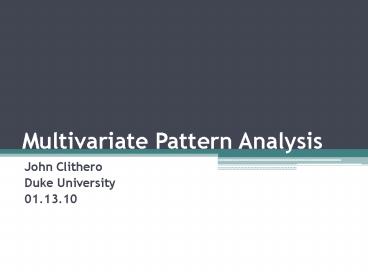Multivariate Pattern Analysis - PowerPoint PPT Presentation
1 / 30
Title:
Multivariate Pattern Analysis
Description:
Multivariate Pattern Analysis John Clithero Duke University 01.13.10 Overview MVPA and fMRI Examples in the Literature PyMVPA Example Motivation for MVPA in fMRI ... – PowerPoint PPT presentation
Number of Views:195
Avg rating:3.0/5.0
Title: Multivariate Pattern Analysis
1
Multivariate Pattern Analysis
- John Clithero
- Duke University
- 01.13.10
2
Overview
- MVPA and fMRI
- Examples in the Literature
- PyMVPA Example
3
Motivation for MVPA in fMRI
- Complements univariate approaches that
investigate the involvement of regions in a
specific mental activity. - Investigates the representational content of
regions. - Distributed responses and representations.
- Model-free vs model-based analysis.
- Machine learning is concerned with developing
algorithms that automatically learn with
experience. - For each example, learn to predict the value of
its label (can be one of two classes, yes/no).
4
MVPA and fMRI data
Norman et al. (2006)
5
Orientation Selectivity in Visual Cortex
Kamitani and Tong (2005)
6
Unconscious Determinants of Free Decisions
Soon et al. (2008)
7
Grey Matter Density and Psychotic Illness
Pattern classification analysis achieved 86.1
accuracy in discriminating patients from controls
using leave-one-out cross-validation.
Sun et al. (2009)
8
Performance Evaluation
- Main goal is accurate prediction.
- How to estimate true error rate?
- Use the entire training data to select classifier
and estimate the error rate - Final model will normally overfit the training
data. - Use N-fold Cross-Validation
- use N-1 folds for training and the remaining one
for testing. - Estimate of true error rate is then an average of
N error rates.
9
What exactly goes into the classifier?
- Features for the classifier will be M voxels.
- Time-compressed preprocessed BOLD signal
(average of 2 or 3 consecutive TRs). - Single-trial beta estimates from a GLM.
- Same voxels but at different timepoints.
- Structural information (e.g., GMD).
10
What exactly goes into the classifier?
- Feature selection can be done in many ways.
- Mean activation level.
- Activation differences between classes.
- Consistent behavior.
- Filter rank all voxels, pick the best M.
- Recursive Rank, pick best P. Repeat.
- Searchlights.
11
Processes of Economic Valuation
Shown is the increase (red) or decrease (blue) in
CV performance when local information from one
ROI combined with local information from another.
Clithero et al. (2009)
12
What does it mean to find common neural patterns
within individuals versus across individuals?
Clithero et al. (Submitted)
13
Comparing Within- and Cross-Participant Models
Clithero et al. (Submitted)
14
Predictive Spatial Patterns and Individual
Behavior
Clithero et al. (Submitted)
15
Dissimilarity Analysis
Is there an elegant way to compare activity
patterns of experimental conditions?
Kriegeskorte et al. (2008)
16
Connecting Research Branches
Kriegeskorte et al. (2008)
17
Odor quality coding and categorization
Howard et al. (2009)
18
Common steps in MVPA studies
- Preprocessing
- Picking a feature space
- Making examples
- Feature selection
- Training/testing
- Correlation/similarity
- Reporting results
19
PyMVPA Terminology
Hanke et al. (2009)
20
An (Almost) Complete Analysis in PyMVPA
- You dont need to know a lot of Python
- to do use PyMVPA.
- PyMVPA is freely available and (sometimes) easy
to install. - MVPA is generally very computationally intensive,
but PyMVPA has optimized many of its scripts. - Analyses can take hours or even days using a
single processor. - Computing clusters make life better if you want
to do large-scale or whole-brain MVPA. - What you need from Python that is probably not
already installed on your linux box
21
Getting your data into PyMVPA
22
Classifier (Lots of Options)
- k-Nearest Neighbor
- Ridge Regression
- Penalized Logistic Regression
- Sparse Multinomial Logistic Regression
- Support Vector Machines
23
Feature Spaces and Selection
- PyMVPA has built-in functions for
- Searchlight feature selection.
- Recursive feature selection.
- To run searchlight analyses for all voxels in
your mask
24
Sensitivity Analysis
25
Confusion Matrices and Generalization
LaConte (2009)
26
Statistics
- Multiple Comparisons (e.g., of searchlights)
- Binomial Tests
- Bootstrap estimates of accuracy variance
- How dependent is accuracy/model on the presence
of specific examples? - Permutation tests
- How likely is the process to bias results
optimistically in the presence of no information
in the example labels?
27
PyMVPA is very flexible
Hanke et al. (2009)
28
Relevant Packages
- SciPy (http//www.scipy.org/)
- Pynifti (http//niftilib.sourceforge.net/pynifti/)
- PyMVPA (http//www.pymvpa.org/)
- LIBSVM (http//www.csie.ntu.edu.tw/cjlin/libsvm/)
- MVPA Toolbox (http//www.csbmb.princeton.edu/mvpa/
) - 3DSVM (http//afni.nimh.nih.gov/pub/dist/doc/progr
am_help/3dsvm.html)
29
(Possibly) Helpful Readings
- Norman et al. (2006). Beyond mind-reading
multi-voxel pattern analysis of fMRI data. Trends
in Cognitive Sciences, 10 424-430. - Haynes and Rees (2006). Decoding mental states
from brain activity in humans. Nature Reviews
Neuroscience, 7 523-34. - Mitchell et al. (2004). Learning to decode
cognitive states from brain images. Machine
Learning, 57145-175. - Mur et al. (2009). Representational content with
pattern-information fMRI an introductory guide.
Social Cognitive and Affective Neuroscience, 4
101-109. - Kriegeskorte et al. (2009). Representational
similarity analysis connecting the branches of
systems neuroscience. Frontiers in Systems
Neuroscience, 2 1-28. - Kriegeskorte et al. (2009). Circular analysis in
systems neuroscience the dangers of double
dipping. Nature Neuroscience, 12 535-540. - Hanke et al. (2009). PyMVPA A Python toolbox for
multivariate pattern analysis of fMRI data.
Neuroinformatics, 7 37-53.
30
Acknowledgments
- Chris Coutlee
- Anne Harsch
- Ed McLaurin
- ODhaniel Mullette-Gillman
- Brandi Newell
- Allison Scott
- Adrienne Taren
- Vinod Venkatraman
- Amy Winecoff
- Richard Yaxley
- Scott Huettel
- McKell Carter
- David Smith































